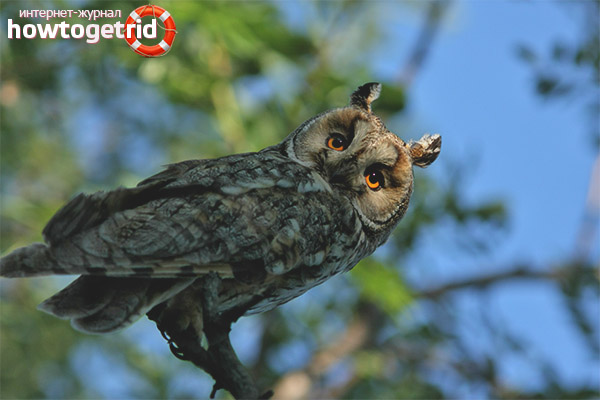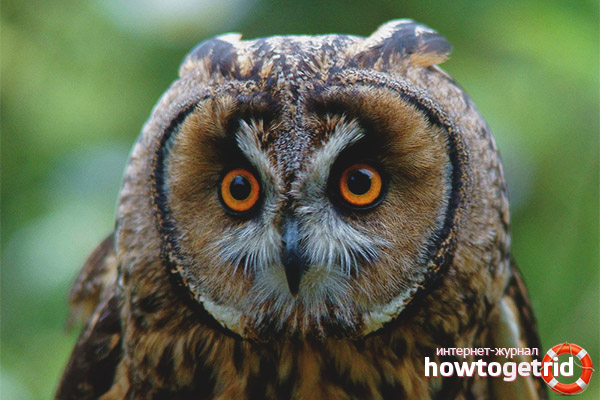The content of the article
Representatives of the eared owl species lead a secretive life. They go hunting only at night. They live in forests in America and Eurasia. The bird belongs to the order of owls, belongs to the family of ordinary owls.
Appearance
A characteristic distinguishing feature of these birds is the presence of "ears". But these are not real ears, but simply sticking out bundles of feathers located on the head of a bird. In fact, their ears are two small holes located on the sides.
Their heads have a round shape characteristic of all owls. The front disc that the feathers form is yellow. Their eyes are orange, rather large. Their beak is black. It is small in size, therefore it is almost invisible on the large face of the bird, which is covered with thick plumage.
The body is slim, medium in size. The wings are long and powerful. Male and female do not differ from each other in appearance.
The plumage has a variegated color, which is very similar in color to the bark of trees. Therefore, when a bird sits on a branch, it is almost invisible to other animals. On the back of a long-eared owl, the plumage has a dark color with bright small dots, on the belly it has light stripes.
The length of an adult bird leaves about 35-38 cm. Their wingspan is a little less than a meter. The bird weighs only 260-300 g, but because of the dense plumage it looks larger.
Living in nature
Related species
The closest species is a swamp owl, which lives in open areas. Also related are the striped, Cape and several other species of owls.
Nutrition
These birds prey mainly on small rodents. Their favorite foods are rats, field voles, and shrews. Sometimes small birds, such as sparrows and some finch, become their victims. Even a large prey like a hare or a jay can eat an eared owl.
When they feed their little chicks, they catch large insects for them. Usually these are various bugs. The place of their hunt is an open area. It can be a field or a clearing. Looking for prey, a long-eared owl soars in the air without making a sound. At the same time, her eyes stare at the area. At night, these birds see perfectly, they can see the prey even on a moonless night. Their hearing is also very sharp. As soon as the long-eared owl realizes that the prey is nearby, it immediately attacks it.
Lifestyle
Almost all eared owls lead a settled life. The inhabitants of the northern part of Europe fly to the southern territory of their range for the winter.
They live in the forest. Most often, coniferous forest is chosen for life, but sometimes they can be found in a mixed forest. Occasionally, a long-eared owl can also be seen in a swamp or in a heather field. Representatives of the species are very common on the territory of their range. There are quite a lot of them in the forests of Europe and Asia. They also live in northern Africa. Northern populations fly south for the winter. Most other species of owls are completely sedentary. In addition to the long-eared owl, several more species belong to migratory birds.
Due to the fact that their plumage is very soft, and their feathers are arranged in a special way, these birds practically do not make any sounds when flying.The plumage is designed in such a way that all the sounds of flight are absorbed. This feature gives the bird a great advantage during the hunt. She can soar and fly up to the victim, not detecting her presence until the last moment.
In the early spring, walking through the forest, you can hear the hoot of a male. It makes muffled sounds that can be transmitted as “oooh.” They are repeated with a break of several seconds. Sometimes it can be a louder and clearer sound or others. In the evening, small chicks may whistle lingeringly. This is reminiscent of a cat's meow or door creak.
During the day they are extremely rare. You can see them in the daytime only sitting on a branch. So they sleep in order to start their hunt again at dusk.
Breeding
The nesting period of these birds falls in March. The female lays from 4 to 6 eggs in one clutch. This can occur 1-2 times a year. Hatching lasts up to 4 weeks, sometimes several days less. Chicks need food and care for 2-3 weeks.
In the spring, the mating season begins. But males can begin to show interest in their future "brides" in the second half of February. The mating dance is a pair’s flight in which the males flap their wings especially hard. They do not build their nests. Instead, they choose a suitable place left by their owners. For example, a nest of magpies or crows. Sometimes they build up in hollows left by proteins. Choosing a suitable dwelling for himself, a long-eared owl slightly changes the situation there. Sometimes they do without nests at all. The female can lay eggs directly on the surface of the earth, choosing a place in the thicket. It can be any open space, for example, a meadow or a clearing.
In one clutch, most often 4-6 eggs. In size, they are slightly smaller than chicken. As soon as the last egg in the clutch is laid, the female begins to hatch them. The male is not involved in this process, but is nevertheless a caring partner. All the while the female sits on the eggs, he brings prey for her. And when the chicks hatch, the father feeds them too.
Sometimes it happens that there is not enough food for everyone. In such years, not all chicks survive. Weak and small die. When they first appeared, their body is covered with white down. Soon it becomes gray, and then brown. The mother not only takes care of the offspring, but also protects him. If a threat appears nearby, it takes the enemy as far as possible, pretending to be wounded.
Observations

Happy flying owl can be seen very rarely. And when she is resting on a tree, it is extremely difficult to notice a bird, since its color almost merges with the tree. Seeing an owl, you can take it as part of a broken branch. Even if a person comes close, a long-eared owl will not fly away.
At night, they are active, vigorously hunting prey. Basically, she preys on rodents, hovering above the surface of the earth, and looking for prey.
Interesting Facts
- Representatives of the eared owl species are able to turn their heads 270 degrees.
- In addition, each of her eyes is capable of simultaneously covering a large view - up to 160 degrees.
- If it is very cold in winter, individuals gather in groups and sleep together, cuddling to keep warm.
- When a group of small birds meets this predator in the daytime, they gather and drive it away. At this time, the owl poses no threat to them.
- An interesting feature of the eyes is their immobility. That is, the bird can only look strictly ahead.
Protection and security
Almost throughout the range, eared owls are quite numerous and widespread. In nature, she has no enemies but man.
Video: Long-eared Owl (Asio otus)











Submit